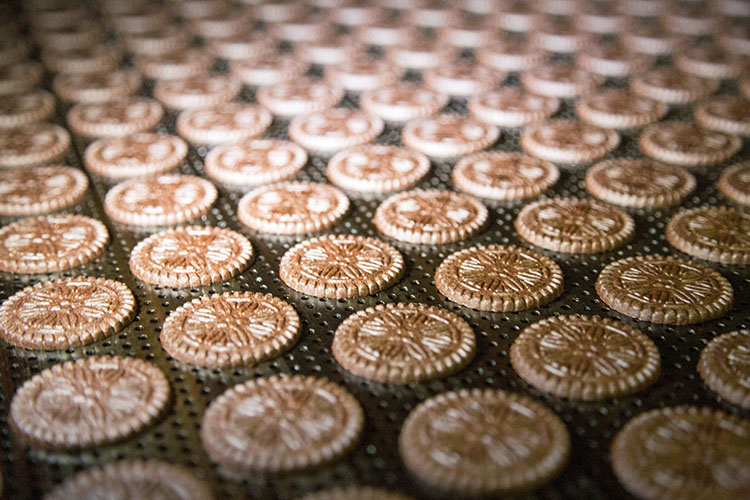
Spending energy with the utmost caution is not a present-day, circumstantial trend. For bakeries, it is a hard reality and will only continue to become more important going forward. Energy savings and sustainability improvements start in the oven.
A complex set of factors and metrics encompass sustainability in bakeries. There is no fixed algorithm to work with, either, as there is a different set of variables that characterize every bakery. There are several ways to assess – and then improve – the sustainability of an operation. Environmental impact is among them, which includes managing carbon footprint and energy consumption.
For baking ovens, the characteristics of the steel belts are one aspect to consider when looking for sustainability improvements. Equally important, however, is to look at the big picture over time and consider the lifetime of the belt. Both solid and perforated steel belts have a considerably longer lifespan, compared to other types of belts. Their working life is typically 20 years or more, often much longer. Steel belts twice this age can still be in operation and perform well. “They are less susceptible to damage, be it through impact, wear and tear, stretching or deformation,” IPCO underlines. This extended timeframe significantly factors in the overall return on investment.
Energy savings when baking depend on numerous factors, including (but not limited to) the design of the oven itself, the product being baked, and the parameters of the baking process. There are other factors to be taken into account in analyzing the efficiency of the baking process, including the energy used in heating the belt throughout the baking process, and in actually moving it through the oven.
Steel belts are lighter than wire mesh so less energy is needed to heat them to the required temperature. “Each time the belt exits the baking chamber, it begins to cool and has to be heated up again. We estimate potential energy savings to be in the region of 30 % for solid steel belts and even more for perforated. Given that as much as 25% of an oven’s energy consumption goes into heating the belt, the savings can be considerable,” IPCO’s specialists calculate. The lighter weight not only benefits the energy spent in baking, but also means less power is needed to ‘drive’ the belt through the oven.

”The laser is installed above the belt and the beam is focused on an area approximately 75 mm wide. As the belt travels under the laser, carbon deposits are burned off and collected by a vacuum system.“
Marko Leber, Global Product Manager, IPCO
Efficiency with perforated steel belts
Various perforation designs make steel belts even lighter than solid ones – good news for the energy needed and for the baking process, too. IPCO perforated belts are available in five standard perforation patterns, with circular hole diameters ranging from 2.0-5.5 mm. Each pattern determines the amount of air that can pass through the belt, allowing different rates of air circulation within the oven. “Tests can be made to determine the optimum perforation for the type of product being baked,” IPCO explains. In most cases, one of the standard patterns will be a suitable choice. If not, custom perforations can be engineered for specific requirements, with hole diameters as small as 0.8 mm, if needed.
The right belt
Determining the exact parameters of the steel belt goes a long way to efficient baking, for a long time. The design of the oven itself and the product portfolio will dictate the best-suitable choice. The type of product being baked is very often the determining factor: “Certain goods – real butter cookies for instance, or chocolate brownies – need the flat, solid surface of a steel belt. Otherwise, the fat would melt into the oven, with the resulting risk of starting a fire. A solid steel belt will also usually be the preferred choice for products such as biscuits, pastries, shortbread and granola bars. Alternatively, perforated steel belts can be a ‘best of both worlds’ option, opening up the possibility of producing both ‘mesh’ and ‘solid belt’ products on the same line,” the baking oven belt specialist illustrates.
Another important aspect, when looking at the operating cost throughout its lifetime and the environmental impact of a product, is the repairing process. This is especially relevant for steel belts, given their extended lifespan. This is where they shine, given their durability and ease of fixing: “Small areas of damage can be patched and larger areas cut out and replaced. Hairline cracks caused by fatigue can be welded, and edge burrs can be filed back,” the specialist details. If a belt is showing signs of deformation, it can be straightened to its previous flat surface, with equipment such as IPCO’s Shotpeener Pro repair tool. “This is a portable unit that is used to blast steel balls at high pressure across the width of a belt as it turns around the terminal drum. This equalizes stresses on both sides of the belt to remove deformations,” its manufacturer explains.
However, steel belts are extraordinarily durable pieces of equipment, so any sign of damage is usually a symptom of a problem elsewhere on the line, rather than a problem with the belt itself. The cause should be addressed to return the process to its initial productivity. But, should such damage occur, it can almost always be rectified.
Making a long lifespan longer
While steel belts do enjoy a money-saving, long lifetime, they can operate within all efficiency parameters considerably longer, if used correctly. TLC might usually stand for ‘tender loving care’, but also: “The three most important things in terms of maximizing the working life and day-to-day performance of a steel bake oven belt are tracking, lubrication and cleaning (TLC),” IPCO underlines.
In terms of tracking, under perfect conditions, a high-quality belt on a properly designed conveyor will run straight and true. However, such conditions are rare in a working environment – temperature changes alone will cause the belt to track one way or the other over time – so steel bake oven belts require some form of tracking. For retrofit installations, the company usually recommends its Compact Belt Tracking 2G system, which uses an optical sensor to monitor the position of the belt edge and enables immediate corrective action, in case of any deviation. “For clean-sheet installations or system upgrades, we can provide integrated active tracking that also incorporates belt tensioning,” says the specialist.
Lubrication minimizes friction, reduces wear, prevents belt distortion, and mitigates the risk of rust caused by condensation. Graphite skid bars are usually the answer, but IPCO can recommend other solutions if needed.
Cleaning, probably the most important maintenance task for bake oven belts, is often a task that can be dirty, difficult and time-consuming. Caustic soda, dry ice, detergent and baking release agents are traditionally used. As a new development for efficient cleaning, IPCO offers a laser cleaning treatment that does the job in about half the time. “The laser is installed above the belt and the beam is focused on an area approximately 75 mm wide. As the belt travels under the laser, carbon deposits are burned off and collected by a vacuum system. Cleaning can be carried out at a rate of between 10-15 m2/hour, depending on the level of build-up, and the entire process can be managed by a single IPCO engineer,” the specialist explains.
Conveying efficiency and beyond
The more efficient the overall system, the greater the energy efficiency. All components contribute to optimum processing if they are set up and managed correctly. For conveyors and their belts, the bigger picture means checking that, “The terminal drums, rollers and skid bars are aligned horizontally and at right angles to the center line of the longitudinal axis of the oven line. Checks should also be made to ensure that terminal drums and all rollers are rotating freely and the tension device is functioning correctly,” IPCO recommends.
Energy savings are made starting with the oven and all related components, one of which is the conveyor belt. But, savings (or unexpected losses) come from any piece of machinery and process setup. While some things are meant to work unchanged for a long time (steel belts), new developments and approaches are coming in to help bake more efficiently.


